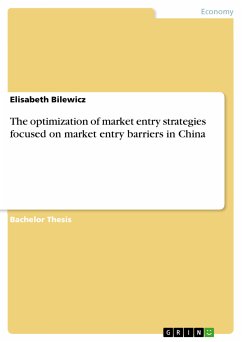Bachelor Thesis from the year 2006 in the subject Business economics - Business Management, Corporate Governance, grade: 1,6, University of Applied Sciences Essen, language: English, abstract: The introduction of this paper as well as the summary and the scope of work are drawn in the first chapter. Chapter 2 deals with the definition and relevance of the problem and outlines the research methods that are applied in this work. The third chapter is composed of the theoretical background for the subsequent case. For this reason chapter 3.1 gives an overview of the relevant market entry strategies. Afterwards an analysis of the selected market entry strategy that is relevant for the case - the joint venture - is given in chapter 3.2. This analysis is subdivided in three areas: a definition (3.2.1), the explanation of different variations of this market strategy (3.2.2.) and finally a critical comment in chapter 3.2.3 which includes a comparison of its advantages and disadvantages. In chapter 3.3 relevant theories for market entry barriers will be introduced. Porters Industry analysis will be described in chapter 3.3.1. Afterwards, the SWOTanalysis, its origin and elements will be explained generally in chapter 3.3.2 and Hofstedes cultural value dimensions will be outlined in chapter 3.3.3. Out of these theories the selected elements for the case part will be illustrated in chapter 3.4. First, the SWOT analysis will be explained in detail in chapter 3.4.1. For this reason the selected market entry barrier elements will be outlined. Again this chapter is sectioned into three parts: a detailed definition of the SWOT elements weaknesses (3.4.1.1) and threats (3.4.1.2) is given, its use is clarified afterwards (3.4.1.3) and a critical comment is drawn finally (3.4.1.4). The elements of Hofstedes cultural value dimension are analysed the same way as the theoretical elements of the market entry strategy and elements of the SWOT analysis. First, all selected dimensions will be defined. Chapter 3.4.2.1 is concerned with Power Distance, followed by the dimensions of Uncertainty avoidance (3.4.2.2) and Individualism versus Collectivism (3.4.2.3.). This definition will be closed with the last dimension: Long-Term orientation in chapter 3.4.2.4. In the following there will given be a critical comment on Hofstedes theory in chapter 3.4.2.5. After the theoretical background is outlined in chapter 3, chapter 4 is concentrated on the case part and the application of the discussed theories and methodologies into a practical environment. [...]
Dieser Download kann aus rechtlichen Gründen nur mit Rechnungsadresse in A, B, BG, CY, CZ, D, DK, EW, E, FIN, F, GR, HR, H, IRL, I, LT, L, LR, M, NL, PL, P, R, S, SLO, SK ausgeliefert werden.









